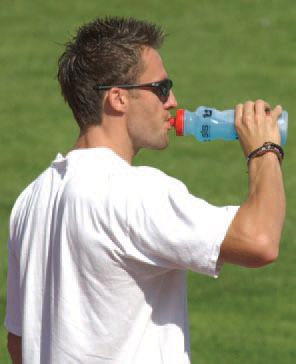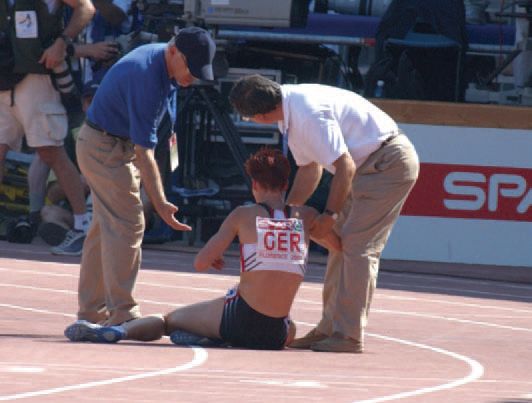
Physiology News Magazine
The Athens Olympics: some lessons in thermal physiology
Ron Maughan continues our series of articles on exercise physiology in the run up to the summer Games
Features
The Athens Olympics: some lessons in thermal physiology
Ron Maughan continues our series of articles on exercise physiology in the run up to the summer Games
Features
Ron Maughan
School of Sport and Exercise Sciences, Loughborough University, Loughborough, UK
https://doi.org/10.36866/pn.55.5
Every few years a major sporting event takes place in an environment that poses special challenges to the participants. It may be altitude, cold or air pollution but, more often, it is heat that causes the biggest problems. Over the years, there have been many examples of spectacular collapses in marathon races, including the examples of Dorando Pietri, who collapsed on the track close to the finish of the 1908 Olympic Marathon in London, Jim Peters, who fell to the track in the Empire Games Marathon in Vancouver in 1954, and many other less high profile problems. These problems are seldom seen when competition takes place in cool environments – although athletes still experience extreme fatigue – and they are most often seen in events lasting an hour or more.
In my days as a physiology student, there was an ongoing debate as to whether the limitation to exercise performance lay in the cardiovascular system or in the active muscles. The re-introduction of the needle biopsy technique for sampling skeletal muscle provided compelling evidence that fatigue in prolonged exercise – at least in cycling, but less convincingly so in running – was a consequence of depletion of the muscle glycogen store. When carbohydrate is not available to the muscles at a rate sufficient to allow the rate of ATP resynthesis to match the rate of hydrolysis, then the energy demand – the speed of running or cycling – must drop to a point where it can be met by fat oxidation. Even in trained athletes, the maximum rate of ATP resynthesis that can be achieved by fat oxidation is only about 50% of that from carbohydrate oxidation.

However, several lines of evidence now suggest that this is irrelevant when exercise takes place in a warm environment. Exercise capacity – measured as the time for which a fixed speed can be sustained – is reduced progressively as the temperature increases above an optimum level, which may be about 5-15ºC. At the point of fatigue in exercise in the heat, the muscle glycogen content remains high, so substrate availability seems not to be limiting. There is also compelling evidence that raising body temperature prior to exercise can impair performance, while pre-exercise cooling can improve performance. These manipulations have little or no effect on the pattern of substrate use in skeletal muscle.
In 1993, Bodil Nielsen wrote in The Journal of Physiology that ‘Physical endurance in hot, dry environments appears to be limited by attainment of a critical level of core temperature, perhaps due to temperature reducing motivation.’ She proposed that attainment of a critical core temperature would inevitably result in fatigue, as a protective mechanism against thermal injury. At the time, objections to Nielsen’s Critical Core Temperature Hypothesis were raised, in particular the failure to provide a plausible biological mechanism for this phenomenon. There was also no evidence of a specific core temperature at which fatigue ensued. However, the typical measure of core temperature in exercise physiology studies is rectal temperature, and no-one would believe that the rectum is the site of fatigue. Since then, however, animal studies have provided evidence that there is a critical level of brain temperature beyond which animals will not continue to exercise voluntarily. The Copenhagen group have applied this to man, providing compelling evidence for a thermal limitation to performance: cerebral heat exchange was measured in exercising subjects by continuous monitoring of aortic and internal jugular vein temperatures during exercise. They found that brain temperature is higher than core (arterial) temperature. At high ambient temperature, heat loss is reduced, so brain temperature rises much faster.

They have also shown an altered EEG pattern in hyperthermia consistent with changes in motor neuron activation thresholds and increased perception of fatigue. In a further study, they showed reduced force generating capacity in individual muscle groups when core temperature was high. Further support for a link between a hot brain and fatigue comes from an abstract presented at last year’s annual meeting of the American College of Sports Medicine. Subjects were exposed to passive heating by a water perfused suit, and the MVC of the knee extensor muscles was measured. Muscle activation was assessed by the twitch interpolation technique. Activation decreased from 80±10% at baseline to 65±11% when rectal temperature reached 38.5°C.
The rise in core temperature during exercise in the heat is limited by evaporative heat loss, but this has two consequences. Fluid loss as a consequence of sweating impairs cardiovascular function, and cardiac output falls. Maintenance of a high rate of evaporative heat loss requires a high skin temperature to maintain the vapour pressure gradient that drives evaporative heat loss. To maintain a high skin temperature, however, requires a high skin blood flow, and a falling cardiac output does not permit this.
Various strategies are available to the athlete to help cope with the conditions anticipated in Athens. Prior heat acclimation improves sweating responses and there is some evidence that it also lowers pre-exercise core temperature. Fluid intake is important in maintaining cardiovascular function and thermal homeostasis, and athletes will look at optimising their hydration strategies. Pre-exercise cooling, and cooling between successive rounds of competition, will be employed by some. How effective these strategies are will have some bearing on who wins the gold medal in some events.
Although we now understand much more about the thermal limitations to exercise performance than we did a few years ago, there are still important lessons from the older literature. In an excellent textbook published in 1919, Bainbridge (he of reflex fame) was able to write that ‘It has long been recognised that the main seat of fatigue after muscular exercise is the central nervous system. Mosso long ago stated that ‘nervous fatigue is the preponderating phenomenon and muscular fatigue is also at bottom an exhaustion of the nervous system.There appear, however, to be two types of fatigue, one arising entirely within the central nervous system, the other in which fatigue of the muscles themselves is superadded to that of the nervous system’. That sounds like a pretty good description of the current state of thinking.
